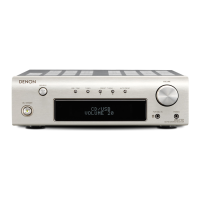Getting Started Connections Setup Playback Setting the Timer Other Functions System Functions
ENGLISH
n
Receiver section
Rated output: 2-channel driving
65 W + 65 W (4 Ω/ohms, 1 kHz, T.H.D. 0.7 %)
Dynamic power: 80 W + 80 W (4 Ω/ohms)
High frequency distortion:
0.1 % (Rated output: –3 dB), 4 Ω/ohms, 1 kHz
Output terminals:
Speaker 4 ~ 16 Ω/ohms
Suited for headphones/stereo headphones
Equalizer amplifier output
(REC OUT terminals):
Rated output : 200 mV
Input sensitivity / Input impedance: PHONO (MM) : 2.5 mV / 47 kΩ/kohms
CD/USB, AUX1, AUX2, Portable In : 200 mV / 47 kΩ/kohms
RIAA deviation:
PHONO : 20 Hz ~ 20 kHz ±0.5 dB
Reception frequency range: FM : 87.50 MHz ~ 108.00 MHz AM : 522 kHz ~ 1611 kHz
DAB : BAND
III 170 MHz ~ 240 MHz
Reception sensitivity: FM : 1.5 μV / 75 Ω/ohms AM : 20 μV
DAB : –93 dBm
FM channel separation: 30 dB (1 kHz)
FM S/N ratio: Monaural : 74 dB Stereo : 70 dB
FM harmonic distortion: Monaural : 0.3 % Stereo : 0.4 %
S/N ratio: PHONO (MM) :
80 dB
(With input terminals short-circuited, 5 mV input signal)
Tone control: SDB : 100 Hz + 10 dB
BASS : 100 Hz ± 8 dB
TREBLE : 10 kHz ± 8 dB
Frequency response:
10 Hz ~ 40 kHz (+0.5 dB, –3 dB) (SOURCE DIRECT: ON)
n
Clock/Timer section
Clock type:
Power line frequency synchronized method (Within ±30 seconds per month)
Timer: Everyday timer / Once timer : One system each
Sleep timer : Max. 90 minutes
n
General
Power supply: AC 230 V, 50 Hz
Power consumption:
44 W
0.2 W (Standby)
Maximum external dimensions:
250 (W) x 82 (H) x 283 (D) mm
Weight: 2.6 kg
n
Remote control unit (RC-1127)
Remote control method: Infrared pulse method
Batteries:
R03/AAA Type (two batteries)
Maximum external dimensions:
49 (W) x 220 (H) x 24 (D) mm
Weight: 110 g (including batteries)
z: For purposes of improvement, specifications and design are subject to change without notice.
Specifications
Symptom Cause Countermeasure Page
Set does not work
properly when
remote control
unit operated.
• Batteries are worn.
• You are operating outside of the
specified range.
• Obstacle between main unit and
remote control unit.
• The batteries are not inserted in
the proper direction, as indicated
by the polarity marks in the
battery compartment.
• The set’s remote control sensor
is exposed to strong light (direct
sunlight, inverter type fluorescent
bulb light, etc.).
• Replace with new batteries.
• Operate within the specified
range.
• Remove the obstacle.
• Insert the batteries in the
proper direction, following the
polarity marks in the battery
compartment.
• Move the set to a place in which
the remote control sensor will
not be exposed to strong light.
3
3
–
3
3
GRemote Control UnitH
Symptom Cause Countermeasure Page
Buzzing noise in
FM broadcasts.
• The antenna cable is not properly
connected.
• Noise interference from a nearby
electronic device equipped with
a microprocessor, or the radio
broadcast signal is weak.
• Connect the antenna properly.
• Reposition the equipment or the
positions or directions of the
connection cables, antenna, etc.
7
–
Hissing or buzzing
noise is heard in
AM broadcasts.
• Noise interference from a
nearby monitor, etc., or there
is interference in the broadcast
signal.
• Turn off the monitor.
• Change the position or direction
of the AM loop antenna.
–
7
Humming noise
is heard in AM
broadcasts.
• There is interference from current
in power cords.
• Try inserting the power plug in
the opposite direction.
–
GTunerH
Symptom Cause Countermeasure Page
iPod cannot be
played.
• The function is not switched to
“iPod (Dock)”.
• Cable is not properly connected.
• Control dock for iPod’s AC
adapter is not connected to
power outlet.
• Switch the function.
• Reconnect.
• Plug the control dock for iPod’s
AC adapter into a power outlet.
12
10
–
GiPodH
Troubleshooting Specifications

